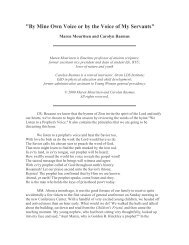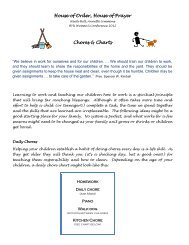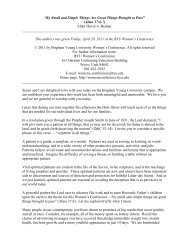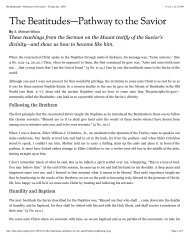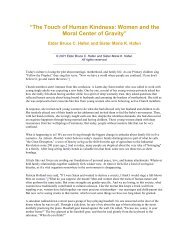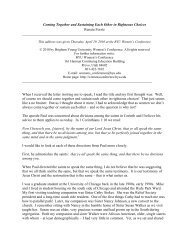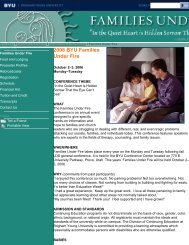Thinking About Divorce? Think again - Continuing Education ...
Thinking About Divorce? Think again - Continuing Education ...
Thinking About Divorce? Think again - Continuing Education ...
Create successful ePaper yourself
Turn your PDF publications into a flip-book with our unique Google optimized e-Paper software.
<strong><strong>Think</strong>ing</strong> <strong>About</strong> <strong>Divorce</strong>? <strong>Think</strong> <strong>again</strong><br />
Lorie D. Fowlke, JD<br />
This address was given at the BYU Families<br />
Under Fire Conference, October 2–3, 2006.<br />
© 2006 by Brigham Young University,<br />
Division of <strong>Continuing</strong> <strong>Education</strong><br />
All Rights Reserved.<br />
For further information write:<br />
Conferences and Workshops<br />
136 Harman <strong>Continuing</strong> <strong>Education</strong> Building<br />
Provo, UT 84602<br />
(801) 422-3559<br />
E-mail: cw136@byu.edu<br />
Home page: http://familiesunderfire.byu.edu
Lorie D. Fowlke, JD
Three Challenges of <strong>Divorce</strong><br />
1. Financial––Burning Through Your Assets<br />
2. Emotional––Pain Does Not Stay Home<br />
3. Social––The Myth of Being Free
1. Burning through your assets
Money lost during the process<br />
of divorce<br />
• Race for control of assets<br />
• Attorney’s fees and court costs<br />
• Temporary support<br />
• Maintain debts
Breaking one household into two<br />
• Dishes, kitchenware, beds, dressers<br />
• Children’s toys, clothes, furniture<br />
• Two mortgages (or rent)
Financial impact after divorce<br />
• Debts do not disappear.<br />
• Banks don’t care.<br />
• Credit scores drop.<br />
• Resources limited: no<br />
more volunteers, lessons,<br />
extracurricular activities.
Lee Lavaki
According to a 2003 Utah State study, divorce costs<br />
Americans $33 BILLION dollars annually or $312 per<br />
household. The average divorce in America costs the state<br />
and federal governments $30 million in direct and indirect<br />
costs. It costs a couple an average of $18,000 to complete<br />
a divorce, which includes lost work productivity, relocation<br />
costs, and legal fees.
2. Pain does not stay home.
Personal pain leading to divorce<br />
• Pain leading to divorce often goes on for years.<br />
• Often involves conflict that impacts self-esteem.<br />
• Both “leaver” and “left” have pain.
Pain of the divorce process<br />
• Resources are wasted.<br />
• System frustration––court rarely<br />
provides satisfaction.<br />
• Aftermath can create resentment,<br />
bitterness, guilt, anger.
Children’s pain––“Is it my fault?”<br />
• Children feel guilty.<br />
• Children do not want to take sides.<br />
• Children never give up (almost always want<br />
parents back together).
Jennifer Salero
Dear Judge: Kids’ Letters to the Judge<br />
Dear Judge:<br />
I want you to undivorce my Mom and Dad. It is not<br />
working out for me.<br />
Sincerely,<br />
Debbie B.<br />
Dear Judge:<br />
Please don’t make me choose.<br />
William
Effects on children<br />
Children in single-parent families are twice as<br />
likely to develop serious psychiatric illnesses and<br />
addictions later in life (The Lancet [Medical Journal],<br />
January 2003).<br />
As of 1997, one million children are involved in a<br />
divorce annually (according to <strong>Divorce</strong>Magazine.com).
3. The Myth of being free
Unrealistic expectations––<br />
what are they?<br />
• I’ll be free of my spouse.<br />
• Conflict will be over.<br />
• Now I can do what I want.
Children connect you forever<br />
• They want you there: birthdays,<br />
recitals, ball games, graduation,<br />
weddings.<br />
• Holidays are split = Christmas or<br />
Thanksgiving alone.<br />
• Access to grandchildren may be<br />
limited.
Vicki Walston
Dating with baggage<br />
• When do you let children and<br />
date meet?<br />
• Children sabotage new<br />
relationships.<br />
• Second families increase<br />
complications exponentially––<br />
new spouse, step-children,<br />
new spouse’s ex-spouse, at<br />
least three sets of<br />
grandparents.
While 50 percent of marriages end in divorce,<br />
60 percent of REMARRIAGES end in divorce.<br />
The marital status with the highest suicide rate<br />
is divorced, as opposed to married, single, or<br />
widowed.
* Sixty-four percent of unhappily married<br />
couples who stayed married reported<br />
themselves as happy five years later.<br />
* Only 19 percent of unhappily married<br />
couples who divorced and remarried<br />
reported themselves as happy five years<br />
later.
Solve the problems before the<br />
divorce; otherwise, you are<br />
just changing gloves without<br />
washing your hands.
There is HOPE . . . answers exist!<br />
• Healthy Dispute Resolution––Learn to<br />
resolve conflict in healthy ways.<br />
• Other-Centered––Live at the highest.<br />
level of the three levels of<br />
relationships.<br />
• Positive Communication––Use and<br />
learn positive communication skills.<br />
• Enjoy your life––Take responsibility––<br />
make the choice!
Lorie D. Fowlke, JD





